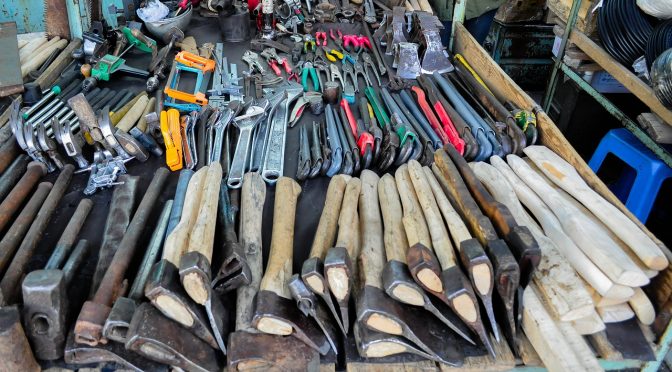There is an old adage, “the right tool for the job” – while this is most frequently used in describing people using completely the wrong tool for the job it is also something that can be considered when looking at generalized work practices and inadequate tools.
Probably my earliest recollection of having the wrong tool for the job was as a child. I was presented with a screw in some toy that needed batteries to be changed. To remove the screw required a crosshead screwdriver and I only had a flat headed screwdriver. The end result as you can imagine was not particularly good. The screw was stripped by me using the wrong type of screwdriver and in the end the battery cover was probably never replaced properly.
The memory is indelibly imprinted on my brain for the simple reason that up until that point in time, I had never actually seen a crosshead screw and never even knew that such a screw existed or that there was a screwdriver for it.
The history of the Phillips screw is rooted in the automobile industry and its popularity is credited to Henry Phillips from Portland, Oregon who founded the Phillips Screw Company in 1934. Also known as the crosshead screw it was invented to provide greater torque and tighter fastenings on the assembly line for power tools.
There’s the important piece “for power tools” – well no wonder I had never seen such a thing before. As a ten year-old I wouldn’t have a power tool for removing screws at my disposal. Sure I could go rummaging in the tool shed and try to find one but back in those days the only people who really had power tools were mechanics in workshops. My chances of success were slim.
Batteries not included
Looking back on those days, I have to now consider the fact that the reason the toy had a crosshead screw was because the speed of the assembly line in the toy factory demanded this approach. No real consideration was being given to the experience that the consumer (like a child) might have with respect to something as commonplace as battery replacement.
Battery operated toys often didn’t even come with batteries in the box or in the toy. The box bore a warning “batteries not included” Something that, today, we may find incomprehensible. There was an inevitability there, at some point you would have to take that cover off and insert or replace batteries.
The need to screw down the battery cover by the manufacturer also likely flowed from mishaps some orally fixated children might have had with swallowing or sucking on batteries – so the manufacturer was limiting risk. Older toys that I had, simply had a swing door with a latch that would sometimes break off – for those, some sticky tape would continue to hold the battery compartment door in place. The older method was functional but only somewhat reliable. It was serviceable though.
The way we work
Returning to my topic. The fact that I used a flat screwdriver to change the batteries didn’t erode my ability to play with the toy. While changing batteries may have now become a difficult activity, the end result largely appeared to be ok. But appearances can be deceiving. The screw might not be fully replaced and the battery compartment may now become unstable and unreliable in holding the batteries in place. The toy gets neglected. The compartment cover comes away and gets lost. The toy is no longer used and it is eventually discarded. This phenomenon is not isolated to battery operated toys. A trip to your neighborhood charity or junk shop will reveal many battery operated gadgets and toys with no battery cover.
This happens with work too. Things that are tougher to do, will often get only a half-hearted commitment in terms of effort especially if they don’t seem to have significant value. Yes, we do the absolutely critical ‘must haves’ irrespective of the amount of effort required and the limitations of the tools at our disposal but an awful lot gets neglected in other areas of our work along the way.
Often our failure to find a better way to work, is because we feel the tools at our disposal are not quite adequate and we don’t feel knowledgeable enough or empowered enough to ask for something new or different. The reason for this, is that we do the job. Implicit in this is the assumption that we know what we need to do the job effectively.
Take a breath
Time and time again though I find this perspective that ‘I have all the tools i need‘ to be wholly untrue, we actually simply use what’s at our disposal or know, most of us only look for a new way to work if we’re tasked with working faster, with elevated quality or because we are new to the job and the current proposed work practices and tools seem inappropriate.
It’s incumbent on us to periodically stop, take a deep breath and consider the value of the work we’re doing, to consider the amount of time we’re wasting and the amount of effort we’re exerting in getting that work done. Are we using the right tools? Do we even know what other tools there are?
Most of us have the whole internet available to us to look for new ideas and tools to do our work with. All we have to do is search for them.
If you’ve recently discovered a new tool to do your work better, I would love to hear from you and how you feel it changed your effectiveness and the quality of your work!
The original version of this article was posted on LinkedIn
Photo by Erdenebayar
